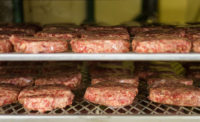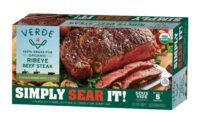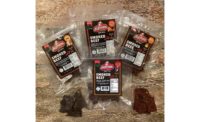The biggest factor that affects the ability of meat and poultry to be formed is the initial quality of the meat. For example, if a processor is making a formed chicken product, use of woody breast meat along with pale, soft and exudative meat should be minimized because functional protein is needed to make a formed product, explains Wes Schilling, a professor of food science in the Department of Food Science, Nutrition and Health Promotion for Mississippi State University in Starkville.
Other items that need to be considered are water source and ingredients. For example, water needs to be free of ions so that it can contribute to oxidation and inhibit the functionality of phosphate, Schilling says.
If phosphate is used, the type of phosphate is important. “Phosphate blends with alkaline phosphates are favorable because they generally lead to enhanced water-holding capacity and better protein bind,” Schilling explains.
One of the challenges then to forming quality products is the increased consumer demand for a variety of formed product textures and end products with reduced sodium, reduced fat, clean labels, etc., says Lynn Knipe, extension processed meat specialist and associate professor in Food Science and Technology and Animal Sciences at Ohio State University in Columbus.
Additionally, processors must meet the consumer demand for different product sizes and shapes, formed products containing inclusions, as well as the never-ending demand for consistency in texture, particle definition, product shape and portion weight, he says. “The challenge of forming such a diverse combination of product characteristics can be overwhelming,” Knipe says.
As Schilling sees it, the biggest challenge to forming technology is the push for clean labels.
“The removal of phosphate makes it difficult to produce a formed product that can be thinly sliced,” he explains. “To replace phosphate, an antioxidant blend, a pH adjustor such as potassium carbonate and a metal chelator need to be included. You can still have a good product without phosphate, but it won’t be as good as if it is used, and it will be more expensive.
“These challenges are being overcome by meat scientists who are doing research projects at universities and in the industry to determine how to make products without phosphates, with less salt, without synthetic antimicrobials, etc., that are still good quality at an acceptable price point.”
In turn, forming equipment suppliers are designing line extensions to their forming machines that are intended for specific product types and characteristics.
“Depending upon the product that a company wants to make, some forming machines use high pressure, and some use low pressure in the forming process,” Knipe says. “Some machines are designed for products with a filling, some are designed for forming a variety of different ground product textures using one machine, and some are designed to form whole-muscle products. Equipment suppliers are also making changeovers easier, as companies switch from one type of formed product to another.”
Advancements also are occurring in the timing of the feeding of the meat ingredients with the forming process, so that there is not too much or too little product arriving at the forming step to properly form products, he explains. In addition, to manage all of the variables that are involved with the forming process, such as product temperature, production speed, product viscosity, forming pressure, etc., computer systems are taking the place of people.
“Processing systems are being designed so that there is a continuous line from grinding through forming and on to cooking and freezing to maximize production capacity,” Knipe says. NP










